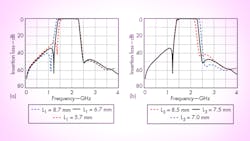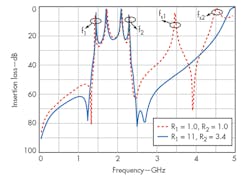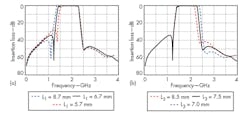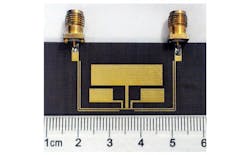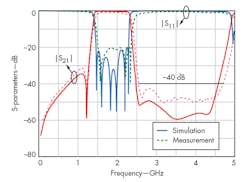Bandpass Filter Combines High Selectivity, Rejection
This file type includes high resolution graphics and schematics when applicable.
Broadband communications systems continue to expand, boosting the need for wideband bandpass filters (BPFs). To meet the needs of those systems, a compact BPF has been developed with high selectivity and good out-of-band rejection. It is based on novel stepped-impedance stub-loaded multimode resonators (MMRs).
Each MMR is constructed of three stepped-impedance stubs (SISs) loaded symmetrically on a resonator with uniform impedance. By using such SISs, a bandpass filter with 48% fractional bandwidth was designed and fabricated. It features as much as 50-dB upper stopband rejection with 35-dB lower stopband rejection.
With the rapid development of broadband communications, wideband BPFs have attracted a great deal of attention for a variety of applications. Thanks to their low cost, compact size, and easy fabrication and integration, the planer filters based on printed-circuit-board (PCB) technology are particularly popular. Recently, various structures have been introduced to realize broadband BPFs, such as substrate integrated waveguide (SIW) structures,1 cascaded lowpass filter with highpass filter structures,2 parallel-coupled line structures,3-5 and different kinds of MMRs.6-12
Various approaches have been applied to the design of BPFs with wide-bandwidth passbands, including the use of a ground plane aperture coupled-line section,3 a three-coupled-line structure,4 and stepped coupled-line structure,5 but the parallel-coupled line structures add complexity. BPFs based on MMRs offer advantages of compact size, low insertion loss, and less design complexity. For example, the use of a stub-loaded MMR enables good filtering performance with compact size.6 The design complex was reduced further using a single stub-loaded MMR.7
Furthermore, wideband BPFs with high selectivity were realized using a class of triple-/quad-mode stub-loaded resonators.8 A compact, high-rejection wideband BPF with improved upper stopband was realized with a quad-mode stub-loaded resonator.9 Also, a stub-loaded MMR was used for a BPF with wideband and high rejection,10 while a wideband BPF with high rejection was realized with a folded stepped-impedance resonator.11
Reference 12 details a stepped-impedance resonator loaded with a uniform-impedance microstrip stub to design a sharp-rejection broadband BPF. Unfortunately, most of the stub-loaded MMRs are constructed by loading constant-impedance stubs, which cannot achieve high selectivity and good out-of-band rejection simultaneously.6-12 Low-impedance stubs support BPFs with good out-of-band rejection but poor selectivity.10-12 In contrast, high-impedance stubs enable BPFs with high selectivity but poor out-of-band rejection.7-9
To achieve a wideband BPF with high selectivity and good out-of-band rejection, a design was developed with a stepped-impedance stub-loaded resonator. The filter’s MMR is constructed by loading three SISs symmetrically on a uniform-impedance resonator. The resonator itself can provide four transmission poles under weakly coupled conditions and six transmission poles under strongly coupled conditions.
Two transmission zeros are obtained beside the upper and lower edges of the passband, helping to significantly improve its selectivity. Rather than uniform-impedance stubs, SISs are used for higher selectivity and better rejection performance over wide stopbands, compared with the conventional wideband BPFs based on stub-loaded MMRs in refs. 6-12.
Figure 1 presents the layout of the proposed BPF. The MMR is constructed by loading one SIS on the center plane and two SISs symmetrically on a uniform-impedance resonator with small dimension L6. According to the analysis in ref. 6, the open-ended stub loaded on the center plane of a uniform-impedance resonator works as a K-inverter between the two resonators, where the open stub and one-half of the uniform-impedance resonator are considered as two independent resonators.
Since the value of L6 is quite small, the main transmission poles and transmission lines can be considered as formed by the two different SISs as well as by the uniform-impedance resonator. By defining the impedance ratios as R1 = Z2/ Z1 and R2 = Z4/ Z3, the resonance conditions for these two SIS units can be expressed as13:
1/R1 = tanθ1(tanθ2) (1)
1/R2 = tanθ3(tanθ4) (2)
Figure 2 shows simulated insertion loss under weakly coupled conditions with variations in impedance ratios R1 and R2. The fundamental resonance frequencies of the two SISs are defined as fi (i = 1, 2), while the first spurious resonance frequencies are defined as fsi (i = 1, 2). Four transmission poles were obtained with weak coupling while as many as six transmission poles can be obtained with strong coupling due to parasitic coupling effects. Only the transmission poles and zeros near the passband edges need be analyzed to reconfigure the cutoff frequencies for this BPF design.
The filter’s transmission pole (f1) and the transmission zero located beside the lower edge of the passband are obtained by means of the SIS in the center plane, while the transmission pole (f2) and transmission zero located near the upper edge of the passband are results of the symmetrical SISs. Figure 3 shows simulated passband insertion loss with changes in filter dimensions, the better to understand the influence of the two types of SISs on the BPF performance. The solid lines represent reference filters.
As Fig. 3(a) indicates, the lower cutoff frequency can be controlled by changing the dimension of the SIS in the center plane. As L2 is varied from 8.7 to 5.7 mm, the lower 3-dB cutoff frequency increases from 1.32 to 1.50 GHz while the bandwidth of the filter tends to decrease. As Fig. 3(b) shows, the upper 3-dB cutoff frequency can be adjusted by altering the dimensions of the symmetrical SISs. As L3 is varied from 8.5 to 7.0 mm, the upper 3-dB cutoff frequency increases from 2.16 to 2.38 GHz and the filter bandwidth tends to increase. By adjusting L2 and L3, the BPF’s upper and lower cutoff frequencies can be tuned independently.
As for the upper stopband performance, the spurious frequencies of the SISs shown in Fig. 2 can be expressed as Eq. 3, according to Eq. 11 in ref. 13:
fsi/fi = π/[2tan-1(1/Ri)] (3)
When Ri > 1, as the value of Ri increases, the spurious frequency tends to increase as well. Based on simulated results under weak coupling conditions, the impact of R1 and R2 on the upper stopband of the proposed BPF can be seen in Fig. 2. When Ri = 1, the out-of-band performance in the upper stopband is quite poor due to the influence of spurious frequencies fs1 and fs2. By properly adjusting the impedance ratios and dimensions of the SISs, a wideband BPF with high selectivity and good rejection performance can be designed.
Based on the analysis, a wideband BPF was designed and optimized. The dimensions of the BPF shown in Fig. 1 were determined as W0 = 2.2 mm; L0 = 29 mm; W1 = 23 mm; L1 = 6.7 mm; W2 = 1 mm; L2 = 7.35 mm; W3 = 4.35 mm; L3 = 7.5 mm; W4 = 0.55 mm; L4 = 5.2 mm; W5 = 0.3 mm; L5 = 28.42 mm; L6 = 0.73 mm; and S = 0.3 mm. The filter was fabricated on a commercial circuit-board substrate with dielectric constant of 2.55 in the z axis (thickness), thickness of 31 mils, and loss tangent of 0.0022. The effective area of the final BPF was 0.26λg × 0.13λg, where λg is the guided wavelength at f0, the center frequency of the proposed BPF.
Figure 4 is a photograph of the fabricated BPF. It was characterized with the aid of a commercial vector network analyzer (VNA) from Agilent Technologies (now Keysight Technologies). The measured performance of the BPF is compared with simulated performance in Fig. 5, with close agreement. The measured 3-dB passband ranges from 1.43 to 2.33 GHz, with a center frequency of 1.88 GHz and fractional bandwidth of 48%. The minimum passband insertion loss was measured at about 0.6 dB. The passband return loss is better than 20 dB.
The BPF has two transmission zeros located at 1.23 and 2.61 GHz, with 41.2 and 47.9 dB rejection, respectively, for high passband selectivity. The filter also achieves better than 32-dB attenuation in the lower stopband while the measured upper stopband extends to 4.7 GHz (namely 2.5f0) with better than 40-dB attenuation.
By making use of a design approach with a stepped-impedance stub-loaded resonator, this BPF achieves compact size, high selectivity, and good out-of-band rejection. Its upper and lower cutoff frequencies can be tuned independently, with measured performance showing a compact BPF with 48% bandwidth.
This file type includes high resolution graphics and schematics when applicable.
Acknowledgments
This file type includes high resolution graphics and schematics when applicable.
The authors wish to thank all readers for their appreciation of this work. The PCB substrate used in this work is TLX-8 from Taconic Plastics. The CAE simulations carried out in this report were based on the use of Advanced Design System (ADS) simulation tools from Agilent Technologies.
Bo Zhang, Master’s Candidate
Beijing University of Posts and Telecommunications, Beijing 100876, People’s Republic of China; 86-10-62283724, FAX: 86-10-62281958
S.S. Li, Master’s Candidate, Professor
Beijing University of Posts and Telecommunications, Beijing 100876, People’s Republic of China
J.-M. Huang, Professor
Beijing University of Posts and Telecommunications, Beijing 100876, People’s Republic of China
Key Laboratory of Information Photonics and Optical Communications, Beijing 100876, People’s Republic of China
References
1. W. Shen, W.-Y. Yin, and X.-W. Sun, “Compact Substrate Integrated Waveguide Transversal Filter with Microstrip Dual-Mode Resonator,” Journal of Electromagnetic Waves and Applications, Vol. 24, No. 14, January 2010, pp. 1887-1896.
2. Q. Chen and J. Xu, “A Microstrip Bandpass Filter Based On Novel Resonators,” Journal of Electromagnetic Waves and Applications, Vol. 26, No. 8, July 2012, pp. 1138-1147.
3. M.K. Mandal and S. Sanyal, “Design of Wide-Band, Sharp-Rejection Bandpass Filters With Parallel-Coupled Lines,” IEEE Microwave and Wireless Components Letters, Vol. 16, No. 11, November 2006, pp. 597-599.
4. Ching-Wen Tang, Chien-Tai Tseng, Shun-Hsing Chiu, and Po-Hsien Wu, “Design of Wide Passband/Stopband Microstrip Bandpass Filters With the Stepped Coupled Line,” IEEE Transactions on Microwave Theory & Techniques, Vol. 61, No. 3, March 2013, pp. 1095-1103.
5. H.N. Shaman, “New S-Band Bandpass Filter (BPF) With Wideband Passband for Wireless Communication Systems,” IEEE Microwave and Wireless Components Letters, Vol. 22, No. 5, May 2012, pp. 242-244.
6. Jae-Ryong Lee, Jeong-Hoon Cho, and Sang-Won Yun, “New compact bandpass filter using microstrip λ/4 resonators with open stub inverter,” IEEE Microwave and Guided Wave Letters, Vol. 10, No. 12, December 2000, pp. 526-527.
7. Lei Zhu and W. Menzel, “Compact microstrip bandpass filter with two transmission zeros using a stub-tapped half-wavelength line resonator,” IEEE Microwave and Wireless Components Letters, Vol. 13, No. 1, January 2003, pp. 16-18.
8. Songbai Zhang and Lei Zhu, “Compact and High-Selectivity Microstrip Bandpass Filters Using Triple-/Quad-Mode Stub-Loaded Resonators,” IEEE Microwave and Wireless Components Letters, Vol. 21, No. 10, October 2011, pp. 522-524.
9. H.-W. Deng, Y.-J. Zhao, X.-S. Zhang, L. Zhang, and W. Chen, “High rejection quadruple-mode broadband BPF with source-load coupling,” Electronics Letters, Vol. 47, No. 1, January 6, 2011, pp. 37-38.
10. Ma Kaixue, K. Liang, R. M. Jayasuriya, and Yeo Kiat-Seng, “A Wideband and High Rejection Multimode Bandpass Filter Using Stub Perturbation,” IEEE Microwave and Wireless Components Letters, Vol. 19, No. 1, January 2009, pp. 24-26.
11. Huan Wang, Qing-Xin Chu, and Jian-Qiang Gong, “A Compact Wideband Microstrip Filter Using Folded Multiple-Mode Resonator,” IEEE Microwave and Wireless Components Letters, Vol. 19, No. 5, May 2009, pp. 287-289.
12. W.-H. Tu, “Sharp-rejection broadband microstrip bandpass filter using penta-mode resonator,” Electronics Letters , Vol. 46, No. 11, May 27, 2010, pp. 772-773.
13. Mitsuo Makimoto and Yamashita Sadahiko, “Bandpass Filters Using Parallel Coupled Stripline Stepped Impedance Resonators,” IEEE Transactions on Microwave Theory and Techniques, Vol. 28, No. 12, December 1980, pp. 1413-1417.
This file type includes high resolution graphics and schematics when applicable.
